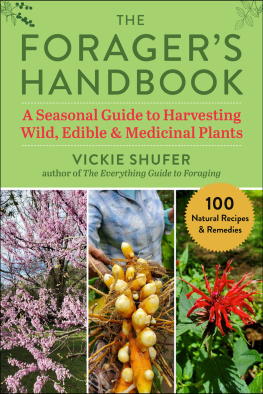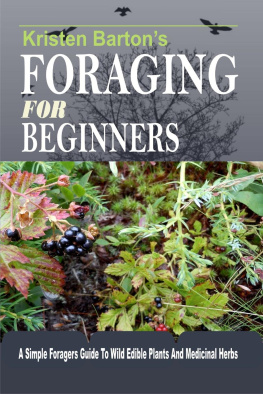
MOUNTAIN STATES
Foraging

115 wild and flavorful edibles
from alpine sorrel to wild hops

BRIANA WILES
TIMBER PRESS
Portland, Oregon
To my husband, Briant, and our son, Salixfor bringing me forever closer to the wild treasures in life
Contents
Preface
How can I forget my Italian grandfathers love for food? He had a garden plot with a variety of grapes, figs, plums, eggplants, tomatoes, and peppers, all staples of his old country. I fondly remember feral pears and apples scattered on Grandpas dashboard. I can taste Grandmas giardiniera and see the giant jars of pickles from the harvests lined up in the basement. I come from a family who loved to celebrate food, and those roots give me passion for everything I do. Whether its the garden I plant and feed my family from or the shrubs that I forage, I am connected to my familys traditions wholeheartedly.
Foraging for food has a feast of fans already. A movement is happening to rewild, regain, and revolutionize our tarnished food system. We want to eat local produce and to know where our food comes from. This can mean getting to know local farmers, food producers, and ranchers. We can also empower ourselves by being gatherers and heading into the woods, not just for the free food but also for respite. Foraging is about returning to the land with humbled hands. Lets learn to take the time to sustainably prune the plants of the forest, spread seeds of the fields, and ensure the success of native plants by tending natures garden.
Spending time in nature, with keen eyes, a slow pace, and a soft impact, is a good thing, but even better is to connect our feet and fingers with the matters of the earth in a way that brings us nutrients. Just a pinch of wild in each dish is a success to celebrate, a way to start incorporating the freedom of foraging.
It is a true blessing to live in a rural town in central Colorado. Here, I am surrounded by different climates within an arms reach: moist mountains, arid sagebrush, and riparian havens. The sands of Utah and the metropolitan Front Range are only four hours away, providing me with yet another variety of plants not found near my home. I cant help but always be prepared to make a few gathering stops on the way.
I chose the plants for this book based on my personal taste preferences and my experience with each plant as food. My wish is to provide the reader with the skills to seek out and harvest a plant with a sustainable mindset and then to preserve your harvest and prepare these feral foods for feast.
My hope is not that this book will sit on a shelf or table but rather that it will somehow land, open, in the hands of a bored child or an adult waiting anxiously for time to pass. When they leave that spot, I want them to greet the lambs quarters, dandelions, and salsify with an irresistible urge to pick a leaf and taste it. This is how foraging lures you in, takes hold of your whole being, and welcomes you to the wild side.

Teaching my son, Salix, to forage for wild strawberries before his first birthday. Every child should know the true flavor of strawberries and experience the joy of finding food from the land.
Introduction: Foraging High and Low
Sit down with this book alongside a weedy sidewalk or a meandering trail among the plants that grow in your habitat. Tickle your palate with wildflowers and colorful fruits that can coexist in the kitchen among your usual dishes. There is something very special about connecting your hands and taste buds to a successfully identified wild edible.

The start of a spring salad is a bowl of violets and bluebells waiting to be washed and trimmed up to use in a spring salad.
Mountain West
The states and provinces of the mountain westColorado, Wyoming, Montana, Utah, Nevada, Idaho, the eastern sides of Washington and Oregon, and north into the southernmost parts of Alberta and Saskatchewanare uniquely their own, with high mountain peaks, broad valleys, high deserts, and lush pockets of forests. Elevation plays a huge role in seasonal changes and precipitation here, with mountains ranging from about 2,000 feet to over 14,000 feet. In these parts, a forager can chase seasons from the low plains all the way to the high country. It can be a bit tricky at times to precisely plan out your harvest because of this. Berry season may be just beginning in the highlands while pickings are already slimming in the low-lying basins.
Within hours of travel by car, the scenery will have changed multiple times, fluctuating between stands of chokecherry, aspen, or scrub oak. Upon gaining elevation, it changes to woodlands, where one might find sweet root, thimbleberry, or cow parsnip. Open meadows may be full of sweet clover, wild chives, and sunflowers, while the desert lowlands provide the wild foodie with Mormon tea, prickly pear, and pion. The land seems endless here, where the mountains soar and the rivers carve through. Let this book be your friend while you explore natures regional gift of foods.
How to Let This Book Guide You
Plants are listed alphabetically by the most common name used in the area. Botanical names of plants are shown in italics, distinguishing plants to genus and often to species, as a binomial. These scientific names are used to more precisely identify plants; common names, confusingly, are often used for more than one plant.
Always use more than one reference to identify a plant. Although this book offers photos and clear indicators for recognizing each plant, you will still need a precise key for distinguishing certain species. I provide general guidance for where each plant may be found growing, but again, this can be quite variable throughout our region.
Each entry lists the edible parts of the plant, along with ideas of how to gather and prepare these feral foods for feast. Food preservation of most plants is discussed, for that longer-lasting bounty that will stock your cupboards and freezer.
Plants vary from being common weeds that can be found in gardens, such as purslane, to crabapples, lindens, and other trees that line the streets of most towns. No need to worry if you cant escape to the wilderness; plenty of wild plants are growing right outside your back door.
Forage safely
Before considering any plant for consumption, be aware of possible cautions, contraindications to medicines, and poisonous look-alikes of that plant. Again, use multiple guidebooks or plant keys to identify plants with certainty. Be sure to check if a plants entry has a cautionary warning before consuming any plant you read about in this book. Never touch or taste any part of a plant you are uncertain about; even a few seeds of poison hemlock or water hemlock can be fatal. Some people have an allergic reaction to sesquiterpenoid compounds, which are present in varying amounts in most plants in the daisy or sunflower family (Asteraceae)small bites until you know for certain you are not one of them! It is always best to sample a small amount of any wild food you have not eaten before. And be aware of the plants that surround you. Some plants can be very irritating to the skin; poison ivy, for example, is one you definitely do not want to grab hold of. With other, even edible plants, like cow parsnip, you run a small risk of dermatitis. If your skin gets sap on it, a burn can occur; again, always read the cautions.
Next page








